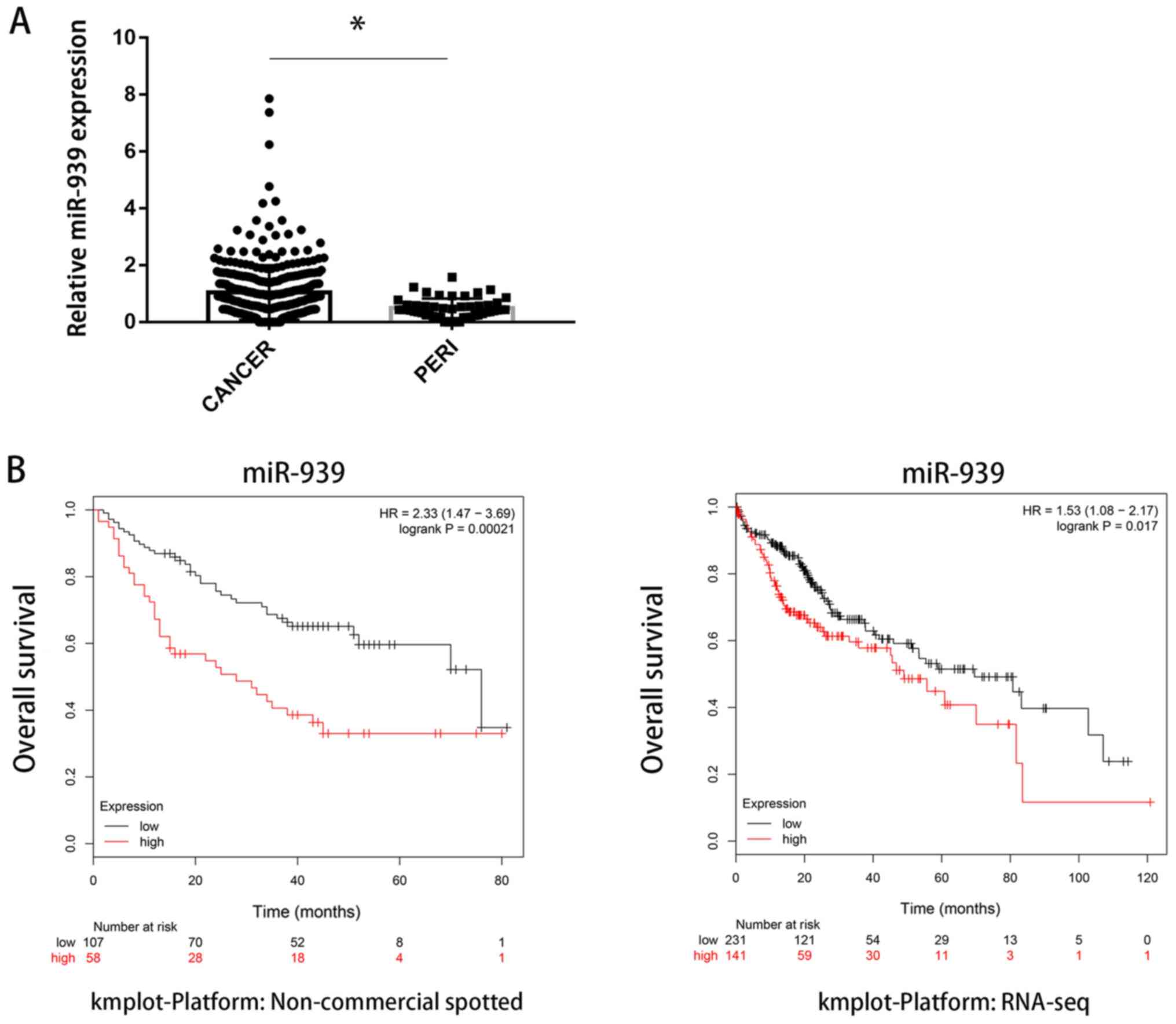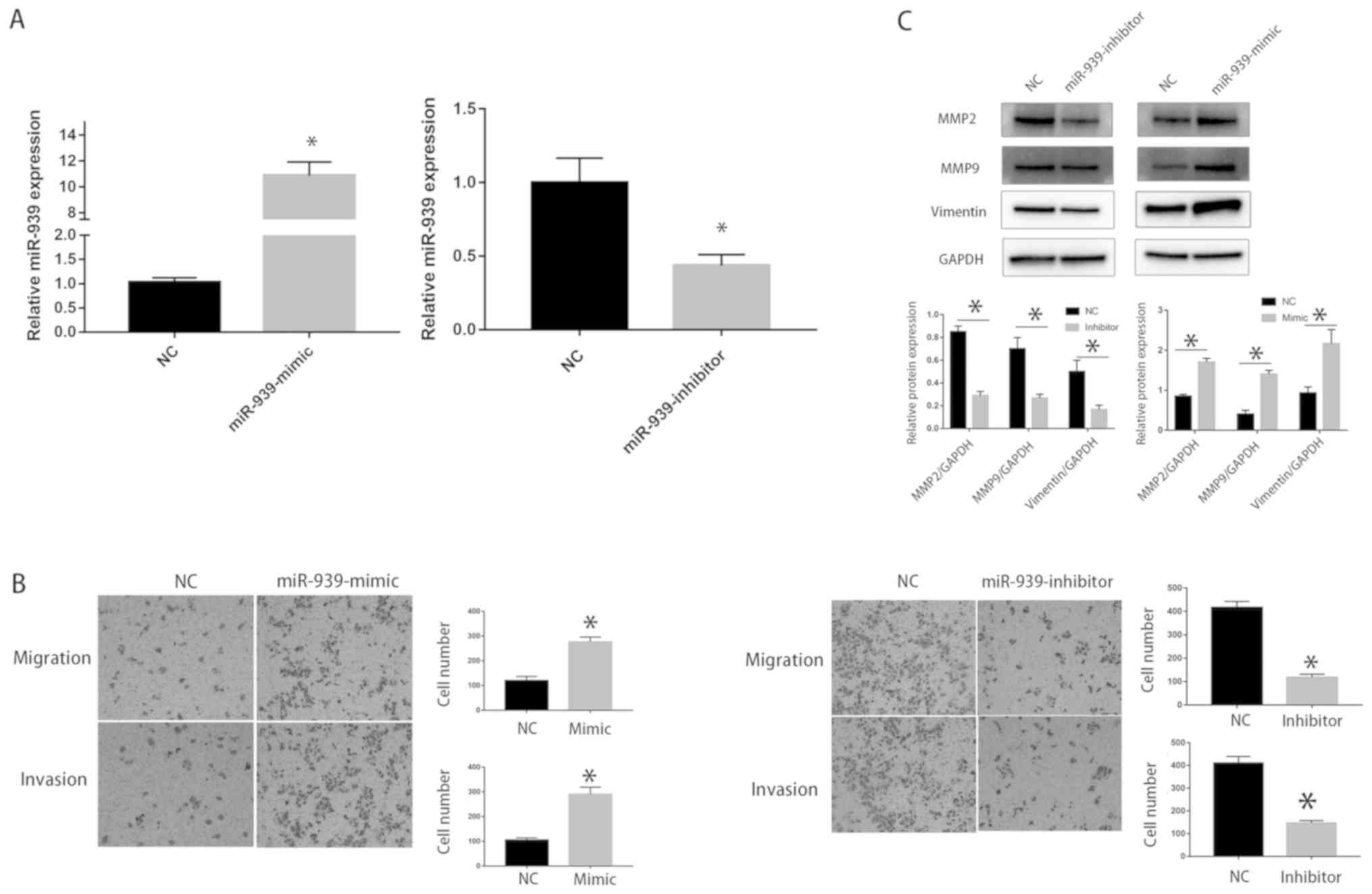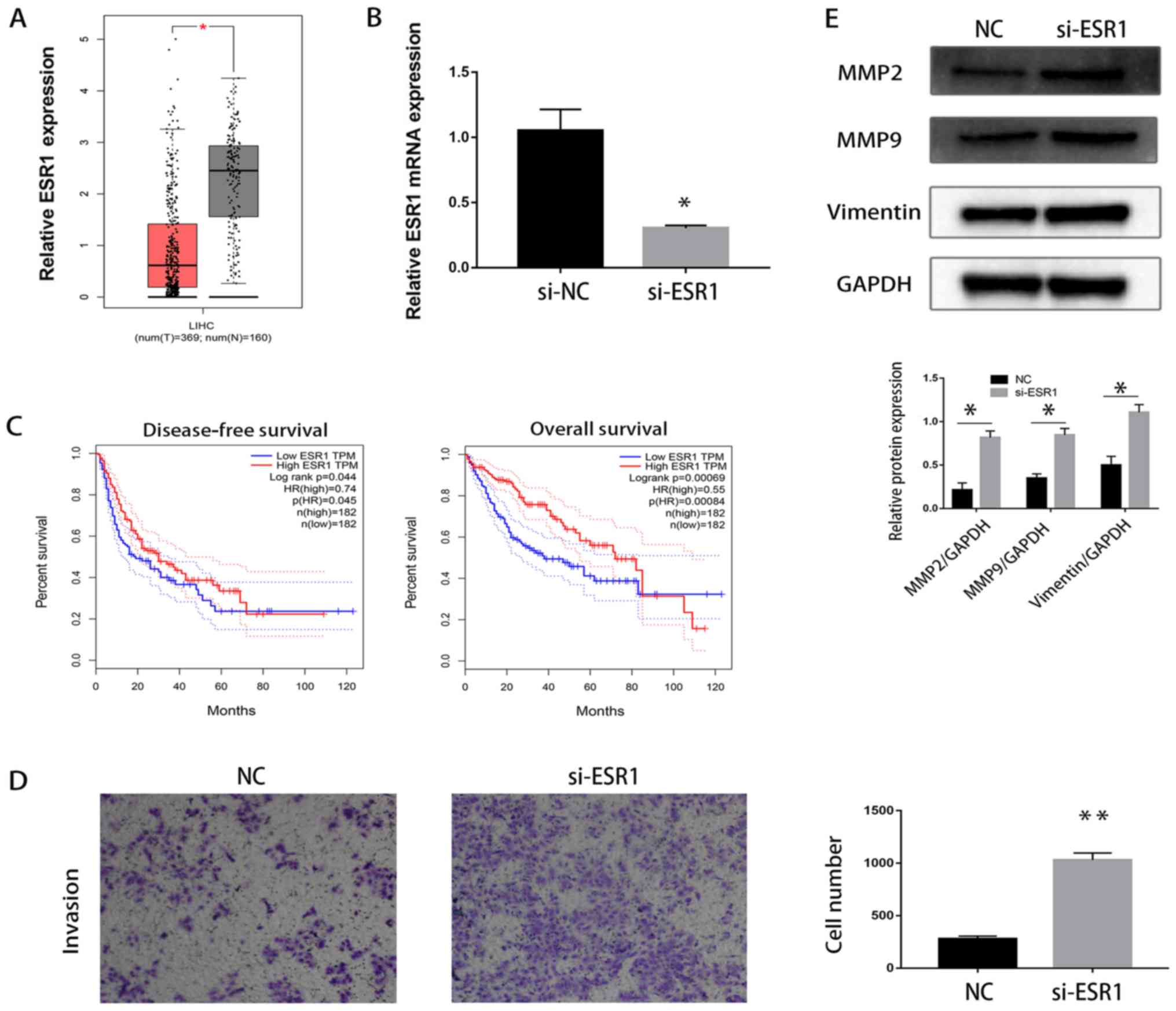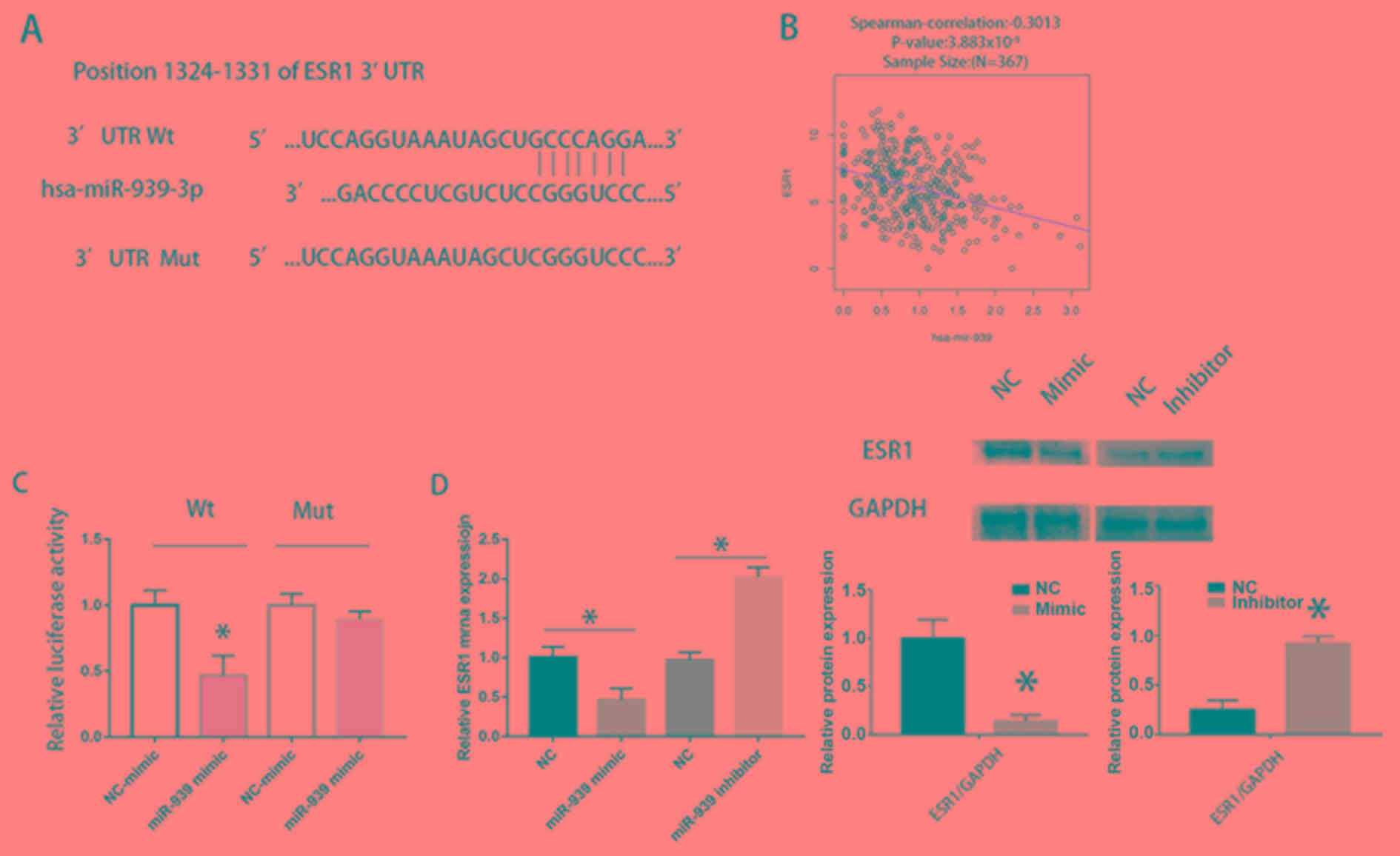Introduction
Hepatocellular carcinoma (HCC) is a type of primary
liver cancer and is one of the most common malignant types of
cancer worldwide, with high morbidity and cancer associated
mortality rates (1). The incidence
rate of HCC in China is the highest in the world due to an
increased rate of hepatitis B virus infection (2). Furthermore, the overall survival rate
has remained unsatisfactory for the last decade at 22–35% (3). Although numerous studies have been
performed, the carcinogenesis and progression of HCC remains
unclear (4–6). Therefore, identifying and clarifying
the molecular mechanisms involved in development and progression of
HCC may improve prognostic outcomes.
It has been reported that microRNAs (miRNAs/miRs),
which are highly conserved, small non-coding RNAs, 19–25
nucleotides in length and abundantly expressed in animals (7,8), may
bind to the 3′-untranslated region (UTR) of target genes and
inhibit the expression of these genes through post-transcriptional
regulation of mRNAs (9). A number of
studies have demonstrated that miRs, including miR-21, miR-197-3p
and miR-497-5p, serve an important role in apoptosis, cell
proliferation, differentiation and metastasis (10–13). A
previous study reported that inhibition of miR-939-3p may suppress
the development of human non-small cell lung cancer (NSCLC) via the
upregulation of metalloproteinase 2 (14). However, to the best of our knowledge,
the function of miR-939-3p in HCC remains unknown.
Estrogen receptor 1 (ESR1), a ligand-activated
transcription factor, may directly bind to the transcription factor
(TF) complex and lead to altered functions of proteins in the
cytoplasm, for examples activation of eNOS or regulation of gene
expression through phosphorylation (15). Numerous studies have demonstrated
that ESR1 acts as a tumor suppressor in various cancer types. Yang
et al (16) reported that
ESR1 directly regulates the hypoxia-inducible factor 1 or the
pathway associated with the anti-estrogen response in breast
cancer. An ESR α inhibitor activated the unfolded protein response,
blocked protein synthesis and induced tumor regression in HCC
(17). Hishida et al
(18) predicted that ESR1 is a tumor
suppressor gene in HCC by triple-combination array analysis.
Additionally, Tu et al (19)
demonstrated that ESR1 overexpression mediated apoptosis in Hep3B
cells by binding with SP1 proteins. However, to the best of our
knowledge, the effect of ESR1 on the metastasis of HCC cells has
not been studied. Therefore, the aim of the present study was to
determine the potential gene binding of miR-939-3p and the function
of miR-939-3p in HCC.
Materials and methods
Tissue samples
The present study was approved by The Institutional
Ethics Committee of Zhejiang Provincial People's Hospital
(Hangzhou, China). The clinical data were obtained from The Cancer
Genome Atlas (TCGA, portal.gdc.cancer.gov/).
Cell culture
The HCC cell line (HCCLM3) was obtained from the
American Type Culture Collection. Cells were cultured at 37°C with
5% CO2 in Minimum Essential Medium (MEM; Thermo Fisher
Scientific, Inc.) containing 10% FBS (Thermo Fisher Scientific,
Inc.). This cell line was authenticated by short tandem repeats
profiling.
Reverse transcription-quantitative
(RT-q)PCR
Total RNA was extracted using TRIzol®
reagent (Invitrogen; Thermo Fisher Scientific, Inc.). RNA was then
reverse transcribed to cDNA using PrimeScript™ RT Master mix (cat.
no. RR036A; Takara Bio, Inc.), according to the manufacturer's
protocol. qPCR was performed using an ABI 7500 (Thermo Fisher
Scientific, Inc.). The primer sequences were as follows: miR-939
forward, 5′-TGGGGAGCTGAGGCTCTG-3′ and reverse,
3′-AGTGCAGGGTCCGAGGTATT-5′; U6 forward, 5′-CTCGCTTCGGCAGCACA-3′ and
reverse, 3′-AACGCTTCACGAATTTGCGT-5′; and ESR1 forward,
5′-CCGGCTCCGTAAATGCTACG-3′ and reverse, 3′-TCCAGCAGACCCCACTTCAC-5′.
U6 was used as the internal control.
Transfection
miR-939-3p mimic, miR-939-3p inhibitor and ESR1
small interfering (si) RNA were obtained from Shanghai GenePharma
Co., Ltd. Cells were seeded in 6-well plates
(3×105/well) and cultured for 24 h before transfection.
Lipofectamine® 3000 (Invitrogen; Thermo Fisher
Scientific, Inc.) was used for transfection, according to the
manufacturer's protocol. The sequences of the miRNAs were as
follows: hsa-miR-939 mimic sense, UGGGGAGCUGAGGCUCUGGGGGUG and
antisense, CCCCCAGAGCCUCAGCUCCCCAUU; mimics negative control (NC)
sense, UUCUCCGAACGUGUCACGUTT and antisense, ACGUGACACGUUCGGAGAATT;
and hsa-miR-939 inhibitor, CACCCCCAGAGCCUCAGCUCCCCA; and inhibitor
NC, CAGUACUUUUGUGUAGUACAA. The sequences of the ESR1 siRNA were as
follows: Sense, GCAAGUUGAUCUUAGUUAAGU and antisense,
UUAACUAAGAUCAACUUGCUG; siRNA NC (cat. no. siN05815122147; Guangzhou
RiboBio Co., Ltd.,) was used as the siRNA negative control, but the
sequence was not provided by the supplier.
Western blot
Tissues or cells were lysed with RIPA lysis buffer
(Thermo Fisher Scientific, Inc.) containing 1% protease inhibitor
cocktail. The concentration of the extracted protein was analyzed
using BCA kit (Beyotime Institute of Biotechnology). Microplate
reader and Gen5 software version 2 (BioTek Instruments, Inc) were
used to detect the quantification of protein expression.12%
SDS-PAGE was used to resolve the proteins, which were then
transferred to PVDF membranes. PVDF membranes were blocked with 5%
fat-free milk at room temperature for 2 h, followed by incubation
with primary antibodies (all 1:1,000) against ESR1 (cat. no.
MA5-14501l; Invitrogen; Thermo Fisher Scientific, Inc.), matrix
metalloproteinase (MMP) 2 (cat. no. MA5-14186), MMP9 (cat. no.
MA5-15886), vimentin (cat. no. MA5-11883) and GAPDH (cat. no.
AM4300; all from Invitrogen; Thermo Fisher Scientific, Inc.) at 4°C
overnight. Subsequently, the PVDF membranes were incubated with the
secondary antibody (1:2,000; cat. no. ab6721; Abcam) for 1 h at
room temperature. Signals were visualized using ECL substrate
(Pierce; Thermo Fisher Scientific, Inc.).
Dual-luciferase reporter assay
PmirGLO plasmids containing the wild-type (Wt) or
mutant (Mut) 3′UTR of ESR1 were purchased from Shanghai GenePharma
Co., Ltd. PmirGLO plasmids were transfected into LM3 cells with
miR-939-3p mimic or inhibitor with Lipofectamine® 2000
reagent (Thermo Fisher Scientific, Inc.). Cells were cultured for
48 h prior to measurement of luciferase intensity. At 48 h
post-transfection, the cells were lysed using
radioimmunoprecipitation assay buffer (cat. no. P0013C; Beyotime
Institute of Biotechnology) according to the manufacturer's
protocol. A F-4500 fluorescence spectrophotometer (Hitachi, Ltd.)
was used to measure the luciferase intensity according to the
manufacturer's protocol and normalized to that of Renilla
luciferase.
Migration and invasion assays
Cell migration and invasion ability was evaluated
using a Transwell assay. LM3 cells (5×104) were seeded
in the upper chamber with FBS-free MEM and the lower chamber
contained MEM supplemented with 10% FBS. For invasion assays,
membranes were coated with 50 µl growth factor-reduced Matrigel (BD
Biosciences). Cell migration and invasion were measured after
incubation for 24 h. Cells were stained with crystal violet dye
solution for 5 min at room temperature, and the number of cells
were counted in five randomly selected fields with a light inverted
microscope at ×200 magnification. Each experiment was repeated
three times.
Bioinformation analysis
We predict the target gene of miRNA with TargetScan
(version 5.0; genes.mit.edu/targetscan). The level of miR-939-3p in
the adjacent normal tissues and HCC tissues and the Kaplan-Meier
survival curve analysis in HCC patients in The Cancer Genome Atlas
(TCGA) were analyzed with miRpower (kmplot.com/analysis/) (20).
Statistical analysis
Data are presented as the mean ± standard deviation
unless otherwise shown. Statistical analysis was performed using
SPSS 19.0 (IBM, Corp.). Significance between groups was analyzed
using an unpaired Student's t-test. The correlation between
miR-939-3p and ESR1 expression levels was examined using a
Pearson's correlation coefficient. The log rank test was used for
survival analysis. P<0.05 was considered to indicate a
statistically significant difference.
Results
miR-939-3p is upregulated in HCC
tissues and is associated with prognosis
miR-939-3p was upregulated in HCC tissues compared
with paired normal tissues based on data obtained from The Cancer
Genome Atlas (TCGA; P<0.05; Fig.
1A). Furthermore, patients with upregulated expression levels
of miR-939-3p exhibited significantly improved overall survival
compared with patients with low expression levels of miR-939-3p in
two different datasets (kmplot.com/analysis/index.php?p=background)
(Fig. 1B).
miR-939-3p regulates migration,
invasion and EMT of LM3 cells
To investigate the function of miR-939-3p,
miR-939-3p mimics and inhibitors were used to increase or decrease
the expression levels of miR-939-3p, respectively (Fig. 2A). LM3 cells transfected with
miR-939-3p mimic exhibited an increased migratory and invasive
capacity (P<0.05; Fig. 2B). In
addition, western blot analysis demonstrated that overexpression of
miR-939-3p significantly upregulated the protein expression levels
of MMP2, MMP9 and vimentin (Fig.
2C). Knockdown of miR-939-3p resulted in a reduction of
invasion and expression of EMT-associated proteins in LM3 cells
(Fig. 2C).
ESR1 is downregulated in HCC tissues
and cell lines, and is associated with a less favorable
prognosis
ESR1 expression was downregulated in HCC tissues
compared with paired normal tissues based on data obtained from
TCGA (P<0.05; Fig. 3A).
Furthermore, patients with lower expression levels of ESR1
exhibited improved overall survival and disease-free survival
compared with patients who exhibited increased ESR1 expression
levels in TCGA dataset (P<0.05; Fig.
3C).
ESR1 regulates the invasion and EMT of
LM3 cells
The mRNA expression levels of ESR1 were lower in LM3
cells transfected with siRNA-ESR1 compared with LM3 cells
transfected with siRNA-NC (P<0.05; Fig. 3B). It was demonstrated that
ESR1-knockdown significantly increased the invasion of HCCLM3 cells
(P<0.01; Fig. 3D). Additionally,
western blotting revealed that ESR1-knockdown increased the protein
expression levels of MMP2, MMP9 and vimentin in HCCLM3 cells
(P<0.05; Fig. 3E).
miR-939-3p directly targets ESR1 and
regulates ESR1 expression levels in HCC cells
Binding of the ESR1 3′UTR with miR-939-3p was
predicted using TargetScan. The Wt and Mut sequences were
constructed and inserted into a PmirGLO vector (Fig. 4A). A significantly negative
correlation between miR-939-3p and ESR1 was observed in the TCGA
dataset (Fig. 4B). A dual-luciferase
report assay was performed to detect the effect of miR-939-3p on
ESR1 promoter activity. Decreased luciferase activity was observed
in the Wt group, whereas no changes were detected in the Mut group
compared with the NC group (P<0.05; Fig. 4C). Western blotting demonstrated that
the protein expression levels of ESR1 were downregulated following
transfection with miR-939-3p mimic in HCCLM3 cells (Fig. 4D), whereas, the reverse was observed
following the transfection of miR-939-3p inhibitor in HCCLM3 cells
(Fig. 4D).
Discussion
HCC is one of the most common tumor types worldwide,
with high morbidity and mortality rates (1). Although numerous oncogenes and tumor
suppressors have been reported in HCC (21–24), the
underlying mechanisms of development and recurrence of HCC remain
unclear. Over the past decade, the overall survival rate of HCC has
remained unsatisfactory and is only 22–35%. A number of genes such
as CAV1, SPOCK1 and PRMT1 (25–27) may
contribute to the metastasis of HCC cells, aberrant expression of
which results in a worse prognosis. Therefore, there is a need to
determine the molecular mechanisms underlying metastasis of
HCC.
miRNAs may bind to the 3′UTR of target genes and
inhibit expression via post-transcriptional regulation (7). A number of studies have demonstrated
that miRNAs participate in the occurrence, progression and
metastasis of tumors, including gastric cancer and colorectal
cancer (28,29). miRNAs are also involved in the
pathogenesis and progression of HCC. Hu et al (24) reported that miR-665 promotes HCC cell
migration, invasion and proliferation by decreasing Hippo signaling
by targeting protein tyrosine phosphatase receptor type B. Wang
et al (30) demonstrated that
downregulation of circDYNC1H1 is associated with inhibitory effects
on cell proliferation and migration in HCC via miR-140-5p. Yu et
al (31) demonstrated that
miR-501 acts as an independent prognostic factor which promoted EMT
via targeting Jun dimerization protein 2 in HCC. However, the
functions of miR-939-3p in tumors have not been extensively studied
in HCC to the best of our knowledge. The present study demonstrated
that the expression levels of miR-939-3p were increased in HCC
tissues and HCC cell lines compared with paired normal tissues and
normal cell lines, respectively. Furthermore, it was demonstrated
that low expression levels of miR-939-3p were correlated with a
more favorable prognosis. Inhibition of miR-939-3p decreased the
metastatic ability of HCCLM3 cells and western blotting revealed
that miR-939-3p may promote EMT via upregulation of MMP2, MMP9 and
vimentin.
An increasing number of studies have demonstrated
that ESR1 may act as a tumor suppressor in various cancer types
(16,19). The present study demonstrated that
the expression levels of ESR1 are downregulated in HCC cell lines
compared with normal liver cells. It was demonstrated that
inhibition of ESR1 decreased the metastatic ability of HCCLM3
cells, therefore ESR1 inhibition was associated with a more
favorable prognosis. Finally, through a dual-luciferase report
assay and western blotting, a direct binding association was
identified between miR-939-3p and ESR1. miR-939-3p may influence
EMT via ESR1, although the present study did not directly show
this. Limitations of the present study include the fact that rescue
experiments were not performed therefore in further studies these
experiments should be performed.
In conclusion, the present study demonstrated that
miR-939-3p serves a role in HCC cell invasion and metastasis.
miR-939-3p negatively regulated ESR1 by binding to its 3′UTR,
therefore the miR-939-3p/ESR1 axis may present a potential target
for treatment of HCC in the future.
Acknowledgements
Not applicable.
Funding
The present study was funded by the Medicine and
Health Research Foundation of Zhejiang Province (grant no.
2017KY018) and the Zhejiang Provincial Natural Science Foundation
of China (grant no. LY18H160043).
Availability of data and materials
The datasets used and/or analyzed during the present
study are available from the corresponding author on reasonable
request.
Authors' contributions
JX designed the study. FC, XYN, LXC and XYW
performed the experiments and analyzed the data. FC and XYN wrote
the manuscript. XYN and XYW revised the manuscript.
Ethics approval and consent to
participate
The present study was approved by The Institutional
Review Board of the Zhejiang Provincial Peoples' Hospital (Taizhou,
China). All patients gave written informed consent to participate
in the study and the data were anonymized.
Patient consent for publication
Not applicable.
Competing interests
The authors declare that they have no competing
interests.
References
|
1
|
Bray F, Ferlay J, Soerjomataram I, Siegel
RL, Torre LA and Jemal A: Global cancer statistics 2018: GLOBOCAN
estimates of incidence and mortality worldwide for 36 cancers in
185 countries. CA Cancer J Clin. 68:394–424. 2018. View Article : Google Scholar : PubMed/NCBI
|
|
2
|
Tan A, Yeh SH, Liu CJ, Cheung C and Chen
PJ: Viral hepatocarcinogenesis: From infection to cancer. Liver
Int. 28:175–188. 2008. View Article : Google Scholar : PubMed/NCBI
|
|
3
|
Ren FH, Yang H, He RQ, Lu JN, Lin XG,
Liang HW, Dang YW, Feng ZB, Chen G and Luo DZ: Analysis of
microarrays of miR-34a and its identification of prospective target
gene signature in hepatocellular carcinoma. BMC Cancer. 18:122018.
View Article : Google Scholar : PubMed/NCBI
|
|
4
|
Brondfield MN, Dodge JL, Hirose R,
Heimbach J, Yao FY and Mehta N: Hepatocellular carcinoma (HCC)
patients listed in short wait regions remain advantaged for liver
transplant (LT) following 2015 HCC policy change. Liver Transpl.
Dec 13–2019.doi: 10.1002/lt.25701 (Epub ahead of print). View Article : Google Scholar : PubMed/NCBI
|
|
5
|
Bakheet AMH, Zhao C, Chen JN, Zhang JY,
Huang JT, Du Y, Gong LP, Bi YH and Shao CK: Improving pathological
early diagnosis and differential biomarker value for hepatocellular
carcinoma via RNAscope technology. Hepatol Int. Dec 12–2019.doi:
10.1007/s12072-019-10006-z (Epub ahead of print). PubMed/NCBI
|
|
6
|
Hu J, Wang E, Liu L, Wang Q, Xia D, Bai W,
Tie J, Li X, Yuan J, Yang S, et al: Sorafenib may enhance
antitumour efficacy in hepatocellular carcinoma patients by
modulating the proportions and functions of natural killer cells.
Invest New Drugs. Dec 13–2019.doi: 10.1007/s10637-019-00885-2 (Epub
ahead of print). View Article : Google Scholar
|
|
7
|
Berezikov E, Guryev V, van de Belt J,
Wienholds E, Plasterk RH and Cuppen E: Phylogenetic shadowing and
computational identification of human microRNA genes. Cell.
120:21–24. 2005. View Article : Google Scholar : PubMed/NCBI
|
|
8
|
Rana TM: Illuminating the silence:
Understanding the structure and function of small RNAs. Nat Rev Mol
Cell Biol. 8:23–36. 2007. View
Article : Google Scholar : PubMed/NCBI
|
|
9
|
Loosen SH, Schueller F, Trautwein C, Roy S
and Roderburg C: Role of circulating microRNAs in liver diseases.
World J Hepatol. 9:586–594. 2017. View Article : Google Scholar : PubMed/NCBI
|
|
10
|
Huang X, Wang L, Liu W and Li F:
MicroRNA-497-5p inhibits proliferation and invasion of non-small
cell lung cancer by regulating FGF2. Oncol Lett. 17:3425–3431.
2019.PubMed/NCBI
|
|
11
|
Ni JS, Zheng H, Huang ZP, Hong YG, Ou YL,
Tao YP, Wang MC, Wang ZG, Yang Y and Zhou WP: MicroRNA-197-3p acts
as a prognostic marker and inhibits cell invasion in hepatocellular
carcinoma. Oncol Lett. 17:2317–2327. 2019.PubMed/NCBI
|
|
12
|
Tang Z, Fang Y and Du R: MicroRNA-107
induces cell cycle arrests by directly targeting cyclin E1 in
ovarian cancer. Biochem Biophys Res Commun. 512:331–337. 2019.
View Article : Google Scholar : PubMed/NCBI
|
|
13
|
Wang J, Chu Y and Xu M, Zhang X, Zhou Y
and Xu M: miR-21 promotes cell migration and invasion of
hepatocellular carcinoma by targeting KLF5. Oncol Lett.
17:2221–2227. 2019.PubMed/NCBI
|
|
14
|
Chen A, Liu S, Lu X, Wei L and Chen Y:
Inhibition of microRNA939 suppresses the development of human
nonsmall cell lung cancer via the upregulation of tissue inhibitor
of metalloproteinases 2. Mol Med Rep. 18:4831–4838. 2018.PubMed/NCBI
|
|
15
|
Bjornstrom L and Sjoberg M: Mechanisms of
estrogen receptor signaling: Convergence of genomic and nongenomic
actions on target genes. Mol Endocrinol. 19:833–842. 2005.
View Article : Google Scholar : PubMed/NCBI
|
|
16
|
Yang J, AlTahan A, Jones DT, Buffa FM,
Bridges E, Interiano RB, Qu C, Vogt N, Li JL, Baban D, et al:
Estrogen receptor-alpha directly regulates the hypoxia-inducible
factor 1 pathway associated with antiestrogen response in breast
cancer. Proc Natl Acad Sci USA. 112:15172–15177. 2015. View Article : Google Scholar : PubMed/NCBI
|
|
17
|
Andruska ND, Zheng X, Yang X, Mao C,
Cherian MM, Mahapatra L, Helferich WG and Shapiro DJ: Estrogen
receptor α inhibitor activates the unfolded protein response,
blocks protein synthesis, and induces tumor regression. Proc Natl
Acad Sci USA. 112:4737–4742. 2015. View Article : Google Scholar : PubMed/NCBI
|
|
18
|
Hishida M, Nomoto S, Inokawa Y, Hayashi M,
Kanda M, Okamura Y, Nishikawa Y, Tanaka C, Kobayashi D, Yamada S,
et al: Estrogen receptor 1 gene as a tumor suppressor gene in
hepatocellular carcinoma detected by triple-combination array
analysis. Int J Oncol. 43:88–94. 2013. View Article : Google Scholar : PubMed/NCBI
|
|
19
|
Tu CC, Kumar VB, Day CH, Kuo WW, Yeh SP,
Chen RJ, Liao CR, Chen HY, Tsai FJ, Wu WJ and Huang CY: Estrogen
receptor alpha (ESR1) over-expression mediated apoptosis in Hep3B
cells by binding with SP1 proteins. J Mol Endocrinol. 51:203–212.
2013. View Article : Google Scholar : PubMed/NCBI
|
|
20
|
Nagy Á, Lánczky A, Menyhárt O and Győrffy
B: Validation of miRNA prognostic power in hepatocellular carcinoma
using expression data of independent datasets. Sci Rep. 8:92272018.
View Article : Google Scholar : PubMed/NCBI
|
|
21
|
Wan J, Liu H, Yang L, Ma L, Liu J and Ming
L: JMJD6 promotes hepatocellular carcinoma carcinogenesis by
targeting CDK4. Int J Cancer. 144:2489–2500. 2019. View Article : Google Scholar : PubMed/NCBI
|
|
22
|
Hu D, Hu Y, Xu W, Yu H, Yang N, Ni S and
Fu R: miR203 inhibits the expression of collagenrelated genes and
the proliferation of hepatic stellate cells through a
SMAD3dependent mechanism. Mol Med Rep. 16:1248–1254. 2017.
View Article : Google Scholar : PubMed/NCBI
|
|
23
|
Wan X, Cheng C, Shao Q, Lin Z, Lu S and
Chen Y: CD24 promotes HCC progression via triggering Notch-related
EMT and modulation of tumor microenvironment. Tumour Biol.
37:6073–6084. 2016. View Article : Google Scholar : PubMed/NCBI
|
|
24
|
Hu Y, Yang C, Yang S, Cheng F, Rao J and
Wang X: miR-665 promotes hepatocellular carcinoma cell migration,
invasion, and proliferation by decreasing Hippo signaling through
targeting PTPRB. Cell Death Dis. 9:9542018. View Article : Google Scholar : PubMed/NCBI
|
|
25
|
Zhang XP, Jiang YB, Zhong CQ, Ma N, Zhang
EB, Zhang F, Li JJ, Deng YZ, Wang K, Xie D and Cheng SQ: PRMT1
promoted HCC growth and metastasis in vitro and in vivo via
activating the STAT3 signalling pathway. Cell Physiol Biochem.
47:1643–1654. 2018. View Article : Google Scholar : PubMed/NCBI
|
|
26
|
Yu H, Shen H, Zhang Y, Zhong F, Liu Y, Qin
L and Yang P: CAV1 promotes HCC cell progression and metastasis
through Wnt/β-catenin pathway. PLoS One. 9:e1064512014. View Article : Google Scholar : PubMed/NCBI
|
|
27
|
Li Y, Chen L, Chan TH, Liu M, Kong KL, Qiu
JL, Li Y, Yuan YF and Guan XY: SPOCK1 is regulated by CHD1L and
blocks apoptosis and promotes HCC cell invasiveness and metastasis
in mice. Gastroenterology. 144:179–191 e174. 2013. View Article : Google Scholar : PubMed/NCBI
|
|
28
|
Feng L, Jing L, Han J, Wang G and Liu Y,
Zhang X, Wang Y, Wang F, Ma H and Liu Y: MicroRNA 486–3p directly
targets BIK and regulates apoptosis and invasion in colorectal
cancer cells. Onco Targets Ther. 11:8791–8801. 2018. View Article : Google Scholar : PubMed/NCBI
|
|
29
|
Liang M, Shi B, Liu J, He L, Yi G, Zhou L,
Yu G and Zhou X: Downregulation of miR203 induces overexpression of
PIK3CA and predicts poor prognosis of gastric cancer patients. Drug
Des Devel Ther. 9:3607–3616. 2015.PubMed/NCBI
|
|
30
|
Wang ZY, Zhu Z, Wang HF, Qin B, Liu J, Yao
XH, Li WC and Chen KS: Downregulation of circDYNC1H1 exhibits
inhibitor effect on cell proliferation and migration in
hepatocellular carcinoma through miR-140-5p. J Cell Physiol.
234:17775–17785. 2019. View Article : Google Scholar : PubMed/NCBI
|
|
31
|
Yu W, Deng W, Zhao Q, Zhuang H, Zhang C
and Jian Z: miR-501 acts as an independent prognostic factor that
promotes the epithelial-mesenchymal transition through targeting
JDP2 in hepatocellular carcinoma. Hum Cell. 32:343–351. 2019.
View Article : Google Scholar : PubMed/NCBI
|


















